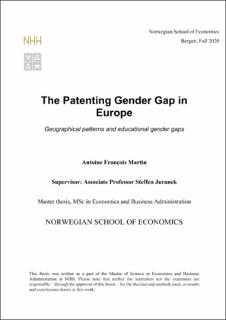The patenting gender gap in Europe : geographical patterns and educational gender gaps
Master thesis
Permanent lenke
https://hdl.handle.net/11250/2736562Utgivelsesdato
2020Metadata
Vis full innførselSamlinger
- Master Thesis [4209]
Sammendrag
With a focus on Europe, the present thesis empirically investigates the geographical patterns
of the patent gender gap as well as the linkage between the patent gender gap and the education
gender gap potentially explaining why women patent less than men. This paper contains a
twofold analysis. Firstly, by a thorough spatial analysis of data covering 267 European regions,
it is shown that, following a pattern similar to global patenting and innovation activity,
women’s patenting is more frequent in cities and their vicinities. Secondly, by developing beta
regression and panel regression models, it is shown that a set of various education-related
gender gaps interdependently affect the severity of the patent gender gap. Being of interest to
innovation agencies and other innovation-policy organisations, the contribution of this study
lies in the analysis of the geographical patterns of women’s patenting as well as the intricate
nature of the causes of a wide, although narrowing, gender gap in patenting and innovation.
